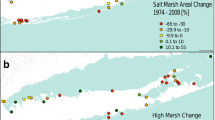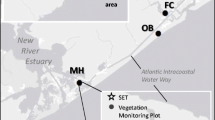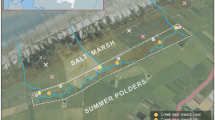Abstract
Efforts are underway to restore tidal flow in New England salt marshes that were negatively impacted by tidal restrictions. We evaluated a planned tidal restoration at Mill Brook Marsh (New Hampshire) and at Drakes Island Marsh (Maine) where partial tidal restoration inadvertently occurred. Salt marsh functions were evaluated in both marshes to determine the impacts from tidal restriction and the responses following restoration. Physical and biological indicators of salt marsh functions (tidal range, surface elevations, soil water levels and salinities, plant cover, and fish use) were measured and compared to those from nonimpounded reference sites. Common impacts from tidal restrictions at both sites were: loss of tidal flooding, declines in surface elevation, reduced soil salinity, replacement of salt marsh vegetation by fresh and brackish plants, and loss of fish use of the marsh.
Water levels, soil salinities and fish use increased immediately following tidal restoration. Salt-intolerant vegetation was killed within months. After two years, mildly salt-tolerant vegetation had been largely replaced in Mill Brook Marsh by several species characteristic of both high and low salt marshes. Eight years after the unplanned, partial tidal restoration at Drakes Island Marsh, the vegetation was dominated bySpartina alterniflora, a characteristic species of low marsh habitat.
Hydrologic restoration that allowed for unrestricted saltwater exchange at Mill Brook restored salt marsh functions relatively quickly in comparison to the partial tidal restoration at Drakes Island, where full tidal exchange was not achieved. The irregular tidal regime at Drakes Island resulted in vegetation cover and patterns dissimilar to those of the high marsh used as a reference. The proper hydrologic regime (flooding height, duration and frequency) is essential to promote the rapid recovery of salt marsh functions. We predict that functional recovery will be relatively quick at Mill Brook, but believe that the habitat at Drakes Island will not become equivalent to that of the reference marsh unless the hydrology is further modified.
Similar content being viewed by others
References
Beeftink, W.G. 1979. The structure of salt marsh communities in relation to environmental disturbances.In: Jefferies, R.I. and Davy, A.J. (eds). Ecological Processes in Coastal Environments. pp 77–93. Blackwell, Oxford, UK.
Bertness, M.D. 1991. Interspecific interactions among high marsh perennials in a New England salt marsh. Ecology, 72: 125–137.
Bertness, M.D., and Ellison, A.M. 1987. Determinants of pattern in a New England salt marsh plant community. Ecol. Monogr., 57: 129–147.
Bird, E.C.F. 1993. Submerging Coasts: The Effect of Rising Sea Level on Coastal Environments. Wiley, New York.
Boumans, R.M.J., and Day, J.W. 1994. Effects of two Louisiana marsh management plans on water and materials flux and short-term sedimentation. Wetlands, 14: 247–261.
Burdick, D.M., and Dionne, M. 1994. Comparison of salt marsh restoration and creation techniques in promoting native vegetation and functional values. Office of State Planning. Concord, NH. 65 pp.
Burdick, D.M., Mendelssohn, I.A. and McKee, K.L. 1989. Production and metabolism of the marsh grassSpartina patens as related to edaphic factors in a brackish, mixed marsh community in Louisiana. Estuaries. 12: 195–204.
Clark J.S. 1986. Late-Holocene vegetation and coastal processes at a Long Island tidal marsh. J. Ecol., 74: 561–578.
Frenkel R.E., and Morlan, J.C. 1991. Can we restore our salt marshes? Lessons from the Salmon River, Oregon. Northwest Environ. J., 7: 119–135.
Herke, W., Knudsen, E., Knudsen, P. and Rogers, B. 1992. Effect of semi-impoundment on fish and crustacean nursery use and export. N. Amer. J. Fish. Mgmt., 12: 151–160.
Josselyn, M., Zedler, J. and Griswold, T. 1990. Wetland mitigation along the Pacific Coast of the United States.In: J. Kusler, A. and Kentula, M.E. (eds) Wetland Creation and Restoration. The Status of the Science. pp 3–36. Island Press. Washington D.C.
Kelley, J.T., Gehrels, W.R. and Belnap, D.F. 1995. Late Holocene relative sea level rise and the geological development of tidal marshes at Wells, Maine, USA. J. Coast. Res., 11: 136–153.
McKee, K.L., and Patrick, W.H. Jr. 1988. The relationship of smooth cordgrass (Spartina alterniflora) to tidal datums: a review. Estuaries, 11: 143–151.
Mitsch, W.J., and Gosselink, J.G. 1986. Wetlands. Van Nostrand Reinhold, New York. 539 pp.
Niering, W.A., and Bowers, R.M. 1966. Our disappearing tidal marshes. Conn. Abor. Bull. 12: 1–36.
Niering, W.A., and Warren, R.S. 1980. Vegetation patterns and processes in New England salt marshes. BioScience. 30: 301–307.
Pethick, J. 1993. Shoreline adjustments and coastal management: physical and biological processes under accelerated sea-level rise. Geogr. J., 159: 162–7.
Race, M.S. 1985. Critique of present wetlands mitigation policies in the United States based on an analysis of past restoration projects in San Francisco Bay. Environ. Mgmt., 9: 71–82.
Rced, D.J., and Cahoon, D.R. 1992. The relationship between marsh surface topography, hydroperiod, and growth ofSpartina alterniflora in a deteriorating Louisiana salt marsh. J. Coast. Res., 8: 77–87.
Roman, C.T., Niering, W.A. and Warren, R.S. 1984. Salt marsh vegetation change in response to tidal restrictions. Environ. Mgmt., 8: 141–149.
Roman, C.T., Garvine, R.W. and Portnoy, J.W. 1995. Hydrologic modeling as a predictive basis for ecological restoration of salt marshes. Environ. Mgmt., 19: 559–566.
Rozsa, R. 1988. An overview of wetland restoration projects in Connecticut.In: Lefor, M. and Kennard, W. (eds) Proceedings of the IV Wetland Conference, pp 1–11. Connecticut Institute of Water Resources, University of Connecticut. Storrs, CT.
Shisler, J.K. 1990. Creation and restoration of coastal wetlands of the northeastern United States.In: J. A. Kusler and M. E. Kentula (eds) Wetland creation and restoration. The status of the science. pp 143–170. Island Press, Washington D.C.
Shreffler, D.K., Simenstad, C.A. and Thom, R.A. 1992. Juvenile salmon foraging in a restored estuarine wetland. Estuaries, 15: 204–213.
Short, F.T. 1987. Production, Nutrition, and Ecological Health of the Wells Salt Marshes. NOAA Tech. Rep. Contract No. NA86AA-D-CZ032. 59 pp.
Short, F.T.M., Davis, W. Gibson, R.A. and Zimmerman, C.F. 1985. Evidence for phosphorus limitation in carbonate sediments of the seagrassSyringodium filiforme Est. Coast. Shelf Sci., 20: 419–430.
Simenstad, C.A., and Thom, R.M. 1996. Functional equivalency trajectories of the restored Gog-Le-Hi-Te estuarine wetland. Ecolog. Appl., 6: 38–56.
Sinicrope, T.L., Hine, P.G., Warren, R.S. and Niering, W.A. 1990. Restoration of an impounded salt marsh in New England. Estuaries, 13: 25–30.
Stevenson, J.C., Ward, L.G. and Kearney, M.S. 1986. Vertical accretion in marshes with varying rates of sea level rise.In: Wolfe, S.A. (ed) Estuarine Variability pp 212–259. Academic, New York.
Stumpf, R.P. 1983. The process of sedimentation on the surface of a salt marsh. Est. Coast. Shelf Sci., 17: 495–508.
Tiner, R.W. 1987. A field guide to coastal plants of the northeastern United States. The University of Massachusetts Press. Amherst, MA. 285 pp.
USDA Soil Conservation Service. 1994. Evaluation of restorable salt marshes in New Hampshire. U.S. Department of Agriculture. Durham, NH. 32 pp.
Warren, R.S., and Niering, W.A. 1993. Vegetation change on a northeast tidal marsh: Interaction of sea-level rise and marsh accretion. Ecology, 74: 96–103.
Zedler, J., Josselyn, M. and Onuf, C. 1982. Restoration techniques, research, and monitoring: Vegetation.In: Josselyn. M. (ed) Wetland restoration and enhancement in California. pp 63–72. California Sea Grant. Report No. T-CSGCP-007, La Jolla, CA.
Zedler, J.B. 1992. Restoring cordgrass marshes in southern California.In: Thayer, G.W.. (ed) Restoring the nation's marine environment. pp 7–52. Maryland Sea Grant College. College Park, MD.
Author information
Authors and Affiliations
Additional information
Corresponding Editor: R.E. Turner Manuseript
Rights and permissions
About this article
Cite this article
Burdick, D.M., Dionne, M., Boumans, R.M. et al. Ecological responses to tidal restorations of two northern New England salt marshes. Wetlands Ecol Manage 4, 129–144 (1996). https://doi.org/10.1007/BF01876233
Received:
Revised:
Accepted:
Issue Date:
DOI: https://doi.org/10.1007/BF01876233




